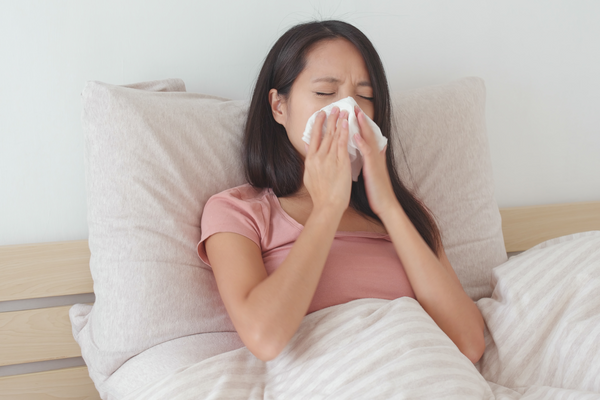What You Need to Know About Mold and Allergies

There’s a fungus among us, and it is mold! Well, mold spores to be exact. While not visible to the naked eye, microscopic mold spores are everywhere, all around us––indoors and outdoors, on plants, household surfaces, and even in the air. Everyone breathes in mold spores, but some people have an allergic reaction or asthma symptoms if exposed to too much of this fungus. What exactly is a mold allergy? And how can you reduce symptoms and find relief? We’ve got the details for you here.
What is a Mold Allergy?
According to the Asthma and Allergy Foundation of America (AAFA), if you have an allergy that occurs over several seasons, you may be allergic to the spores of molds or other fungi. As mentioned above, mold, mildew, and fungi are all around us. Molds are different from plants in animals in how they reproduce and grow. The “seeds,” called spores, travel easily through the air. Touching or inhaling the spores causes allergic reactions in some people. Generally, allergic symptoms from mold spores are most common in the summer months. However, molds grow indoors and outside, so allergic reactions can occur year-round.
What Are the Common Symptoms of a Mold Allergy?
The symptoms of a mold allergy are often very similar to the symptoms of other allergies and may include:
- Sneezing
- Congestion
- Nasal stuffiness and runny nose
- Red, itchy, or watery eyes
- Dry cough
- Shortness of breath
- Dry, scaling skin
Touching or inhaling mold or mold spores can cause a person who was not previously allergic to mold to become allergic to mold. Mold exposure can also trigger asthma attacks and symptoms such as cough, wheezing, and shortness of breath. Sometimes, a mold allergy can cause delayed symptoms, leading to nasal congestion or worsening asthma over time. If you experience a worsening of symptoms when you’re in a damp or moldy area like an unfinished basement or shed, it may mean that you have a mold allergy. If you’re not sure about what is triggering your symptoms, be sure to consult your doctor, allergist, or immunologist to diagnose your condition and find the best course of treatment.
The Health Effects of Mold Exposure
Airborne mold spores constantly land and stick to surfaces. And, if the conditions are sufficiently warm, damp, and undisturbed, the spores will extrude tendrils that turn almost any surface into food. Carpet, wood, shower curtains, bathroom tiles, even dust; just add water, and it’s all food to mold. A telltale sign of mold growth in the home is a musty or earthy smell. As mold grows, it can emit gasses known as microbial volatile organic compounds (MVOCs). Technically, it’s not just the mold you are smelling but the chemical compounds released at different stages of the mold’s growth.
So, what effect does all this fungal activity have on human health? Generally speaking, we know that there are two main ways mold can engage the immune system, and they depend on whether your system is underpowered or overactive. Suppose you have a weakened immune system, for example, if you’re undergoing chemotherapy or have recently had an organ transplant, spores can readily colonize the lungs and begin treating your body as it would concrete or wood paneling, says Professor Matthew Fisher, an epidemiologist at Imperial College London.
On the other hand, if you have an overactive immune system, your body will sound the alarm by triggering an allergic response when exposed to mold spores and filaments. These annoying, microscopic filaments land on the mucous membranes of our eyes, nose, and mouth, causing itching, sneezing, eye-watering, coughing, or even asthma attacks.
If a toxic mold, such as Aspergillus fumigatus, colonizes inside of your home, you’ll be inhaling those spores every day, and you may potentially become sensitized to them. Sensitization means your body recognizes a substance and mounts a highly aggressive response to even the faintest traces of it. Those with asthma who are exposed to toxic mold are susceptible to developing a particularly severe form of “fungal asthma.”
Even more alarming, numerous studies show that infants exposed to mold have a much higher risk of developing childhood asthma. Maternal smoking is the only thing more correlated with childhood-onset asthma than mold exposure.
How Can a Mold Allergy Be Prevented?
Unfortunately, there is no cure for allergies. But, like other allergic reactions, mold allergy symptoms can be relieved or prevented by reducing exposure to the allergen. Here are some tips on how to avoid indoor and outdoor molds:
- Limit your outdoor activities when mold counts in your area are high. This will lessen the number of mold spores you inhale and your symptoms. Mold counts will be exceptionally high outdoors after heavy rainstorms.
- Wear a dust mask (a 3M surgical mask with a particulate filter is ideal) when cutting grass, raking and picking up leaves, working in the garden, digging around plants, and disturbing other plant materials.
- Remove shoes before coming inside. Not only is wearing outside shoes indoors a health risk, but it can also increase allergens inside the home. Wet leaves and soil stuck to the bottom of your shoes can bring in mold and mildew, and pollutants from grass often get trapped on the bottom of shoes. Take your shoes off outside, or put them inside a washable tray as soon as you walk in the door. Taking just a few seconds to remove your shoes each time you come in from the outside can reduce mold allergens (as well as bacteria and germs) in living areas.
- Lower your indoor humidity. Hot, humid houses are breeding grounds for mold and mildew. Maintain the temperature between 68F and 72F and keep relative humidity below 60%, ideally between 35-50%. Dehumidifiers remove excess moisture from the air, and air conditioners maintain the overall temperatures comfortable without opening windows and letting in the humid air. An air conditioning unit with a high-efficiency particulate air (HEPA) filter will help to trap mold spores before they can come inside. Be sure to change filters regularly.
- Don’t overwater indoor plants. If you have houseplants, take care not to overwater; it encourages mold in the soil. If you suffer from a mold allergy, keep houseplants out of the bedroom.
- Tackle household mold ASAP. If mold is a problem in your home, first clean up the visible mold (seek expert help if needed) and eliminate the excess moisture, making sure to address any leaks. Use Vital Oxide to get to the root of the problem and to help keep mold and mildew from coming back. Vital Oxide is a proven mold and mildew killer with up to seven months of residual effects. It’s also safe to use on surfaces traditional mold and mildew killers would damage, such as carpeting and marble. P.S., Vital Oxide is highly effective in removing and reducing cockroach matter and allergens.
- Regularly clean mold-prone surfaces around the home with Vital Oxide to help prevent mold from growing in the first place. Focus on bathroom surfaces, kitchen surfaces, window sills, and other moisture-prone areas. Vital Oxide controls mold growth on hard and soft surfaces.
- Ventilate the bathroom. Your bathroom is the most naturally humid room inside your home, making it attractive to mold and mildew. Opening the windows or using an exhaust fan (and making sure it's vented to the outdoors) helps reduce moisture accumulation during and after showers and baths.
- Stay on top of laundry. Damp towels, wet swimsuits, sweaty gym clothes, and other laundry provide an ideal environment for mold. Always hang wet laundry to dry, or toss them in the washer along with your Anti-Allergen Laundry Detergent.






